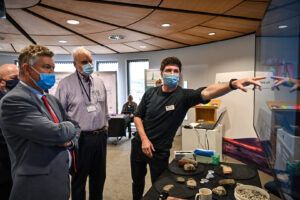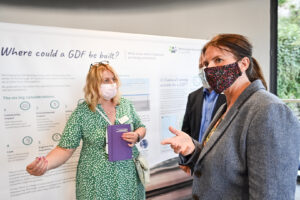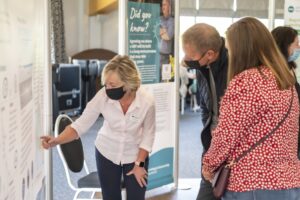Welcome to the September edition of the Copeland GDF Working Group newsletter. Today we present our proposals for the formation of two Community Partnerships in Copeland to take forward the work we began 11 months ago. We also bring you a report and photographs from our 10-venue public exhibition roadshow over 14 days earlier this month.
Our recommendation is for the formation of two Community Partnerships, each with its own Search Area, to look at potential siting of a Geological Disposal Facility (GDF) in more detail. It’s a starting point and would involve a larger group of people which would take over from the Working Group to further progress those discussions and conversations to see what this could mean for Copeland.
This is a proposal and we are still in the very early part of the GDF journey. It’s up to the local authorities and RWM to now decide whether we progress further to forming Community Partnerships. No decisions about the siting of a GDF have been made – this is potentially a long journey which has to have both a suitable site and approval from the community. Without either of those it would not go ahead – see further in the newsletter for more.
Talking to people across Copeland at our face-to-face exhibitions has been an excellent way to hear people’s views – we’ve seen hundreds of people, who have asked hundreds of questions and given us their thoughts. Thanks to all for coming along.
The range of community engagement we have had at the public exhibitions, the pop-up events over summer, the webinars and the many other conversations, has been crucial for the Working Group to consider in our three tasks: begin to understand community issues, examine any concerns and questions the public has about a GDF; identify a search area or areas within Copeland and recruit initial members for a Community Partnership which could take that work forward.
If the proposals are agreed, Community Partnerships will be launched in Copeland to explore geological disposal further.
As always, to get in touch email: gdfinfo-copeland@nda.gov.uk telephone 0300 369 0000 or write to: Copeland GDF Working Group, GDF Enquiries, PO Box 734, Swansea SA1 9RP. Our website is: https://southcopeland.workinginpartnership.org.uk/

Mark Cullinan Independent Chair Copeland GDF Working Group

Copeland GDF Working Group proposes two Search Areas and Community Partnerships
Copeland GDF Working Group has been working towards identifying Search Area(s) for further consideration in the search for suitable sites to host a Geological Disposal Facility (GDF).
A GDF is an underground facility designed to safely and securely dispose of higher activity radioactive waste. A Search Area is the geographical area on land within which Radioactive Waste Management (RWM) would seek to identify potentially suitable sites.
The Working Group is proposing two Search Areas, each with its own Community Partnership. Search Areas have to be based on district electoral ward boundaries. The area within the Lake District National Park (LDNP) and proposed extension will continue to be excluded from consideration, even where these electoral ward boundaries may overlap with the park boundary.
Deep geology beyond the coast is also being considered for the siting of the underground elements of a GDF and the Working Group has recommended that RWM’s initial focus is in this area. This means a surface facility on the coast could provide access to a disposal area deep in the rock beyond the coast, where – based on existing data – the Working Group and RWM understands there may be geology worthy of further detailed investigation.
There are no plans to consider using existing or future coal mines for the geological disposal of radioactive waste, because they will not be suitable.
One Search Area includes the electoral wards of Gosforth & Seascale and Beckermet. The second Search Area includes the electoral wards of Millom and Black Combe & Scafell.
Mark Cullinan, Chair of the Copeland GDF Working Group, said: “Over the past 11 months we have talked with local people and looked at the data available. The Working Group feels confident that we have selected two Search Areas worthy of further consideration as an initial starting point going forward.
“We are still in the very early part of the GDF journey and it’s up to the local authorities and RWM to now decide whether we progress further to forming Community Partnerships. We look forward to their decision in the coming weeks.”
The Working Group’s identification of the Search Areas has involved looking at readily available information on the local geology, environmental issues, transport infrastructure and safety – as well as information from previous work in the area.
Starting a conversation with local people has been a key activity since the Working Group was formed last November and the views received so far have been used to inform members, alongside other local information.
A Community Partnership is a longer-term group made up of a larger number of people which would take over from the Working Group and consider the possibilities of GDF siting in more detail. Initially the Working Group would start to recruit some community members and then any Partnership would recruit further potential members to join them to take it forward.
Both Search Areas would be considered by RWM to identify potentially suitable sites to host a GDF. A surface facility, which would be the entry point for a GDF, would require up to 1 sq km of land and would require suitable transport links.
The underground part is likely to require anywhere between 10-20 sq km, of suitable geology deep underground. The underground disposal areas do not need to be located directly below the surface site – they could be separated by many kilometres.
Progressing to the formation of Community Partnerships would unlock an initial sum, for each partnership, of up to £1m a year funding for local projects, rising to £2.5m per year if deep borehole investigations to assess geology take place.
Chair Mark Cullinan added: “The work of a Community Partnership – which would involve members of the community, at least one principal local authority and RWM – would include further public engagement and creating a ‘Community Vision’ for the long-term well-being of the community.
“No decision has been taken on any specific locations for a potential GDF. Identifying these Search Areas is a starting point which will allow RWM to initiate investigative works and the Community Partnership to extensively engage with local people over several years.”
Construction of a GDF requires both a suitable site and willing community. If a suitable site is eventually found in Copeland – which could take 10-15 years – a Test of Public Support (such as a poll or referendum that gives people a direct say) would be held with those living in the wards affected. Without public support the project would not go ahead.
If Community Partnerships are formed, residents in these wards will receive information giving further details, and how people can get involved.

Q&A
What is a GDF?
A Geological Disposal Facility, or GDF, is an underground facility designed to safely and securely dispose of radioactive waste. It involves building a series of specially designed and engineered vaults and tunnels deep underground at a depth of between 200 and 1000 metres. It could potentially be three times deeper than the height of the Shard in London, Britain’s tallest building. Once the waste is placed inside a GDF, the facility is sealed. By combining engineering with the natural barrier of appropriate geology, it’s designed to keep protecting people and the environment for hundreds of thousands of years, while the radioactivity fades away naturally.
What area is being considered for a GDF in Copeland?
One Search Area includes the electoral wards of Gosforth & Seascale and Beckermet. The second Search Area includes the electoral wards of Millom and Black Combe & Scafell. The Search Areas identified (not including those areas however that fall in the Lake District National Park and the proposed extension) plus up to 22km beyond the coast have been identified as a proposed starting point for the potential siting of above and below ground geological disposal facilities.
How did you arrive at today’s proposal?
The Working Group had three main tasks: begin to engage with the public about geological disposal; identify a search area or areas within Copeland and recruit initial members for a Community Partnership. Today’s proposal was reached following extensive work which has been conducted since the Working Group was formed in November. The focus of community engagement was to start to understand the local area and any issues or questions the community within it might have. This has included providing information about GDF and the siting process, hearing local views and answering questions. The work has also involved looking at available information on the local geology, environmental issues, transport infrastructure and safety – as well as information from previous work in the area.
How have the views of local people been taken into consideration?
The Copeland GDF Working Group has had hundreds of conversations with people since it was formed in November 2020. Those wide-ranging views have been considered by the Working Group and fed into this very early part of the process as it has progressed and there will be further extensive opportunity to continue those conversations with the Community Partnership.
What is the difference between a Working Group and a Community Partnership?
A Community Partnership is intended to be a larger enduring group which would take over from the Working Group and consider the possibilities of GDF siting in more detail, including further public engagement and creating a ‘Community Vision’ for the long-term well-being of the community. It would be a partnership between members of the community in the Search Area, at least one principal local authority (such as district or county council) and Radioactive Waste Management (RWM).
Who would be on a Community Partnership?
A Community Partnership must have at least one relevant principal local authority, alongside the developer – RWM – and members of the community and individuals. The aim is for the membership to be reflective of the local community in the Search Area. Community Partnerships should also seek to include representation from parish and town councils, who may be recruited via a selection panel of Working Group members. Further community members would be recruited to join a Partnership as it continues to evolve over time.
Who is entitled to funding if Community Partnerships are formed?
Progressing to the formation of Community Partnerships would unlock an initial sum of up to £1m a year funding for local projects, rising to up to £2.5m per year if deep borehole investigations to assess geology take place. The funding is available to projects that would benefit communities in the Search Areas covered by the Community Partnerships. Projects that receive funding do not have to be based in the Search Area, unless that is one of the locally-specified criteria (see below), but do have to benefit the communities in the Search Area.
What can the Community Investment Funding be used for?
It can be used to fund projects, schemes or initiatives that:
- Improve community well-being – for example improvements to community facilities, enhancement of quality of life, or health and well-being
- Enhance the natural and built environment – including cultural and natural heritage especially where there is economic benefit – eg through tourism
- Provide economic development opportunities – for example employment, job creation, skills development, education or training, promotion of local enterprise, long-term economic development or economic diversification
The Community Partnership may also define its own locally-specific criteria, in line with these three main principles.
What are the other benefits of a GDF?
A GDF is a multi-billion pound infrastructure investment. It is estimated that a GDF will provide jobs and benefits to the economy for more than 100 years. Current estimates are it will directly employ around 600 skilled, well-paid staff per year, over the duration of the project, with workforce numbers rising to more than 1,000 during construction and early operations. The community that takes the opportunity to host a GDF will also receive significant additional investment.
Is there a connection between any potential for a GDF in Cumbria and plans for a deep coal mine in Whitehaven?
There are absolutely no plans to consider existing or future coal mines for the geological disposal of radioactive waste, because they are simply not suitable. RWM is responsible for developing a deep GDF in the UK, where higher-activity radioactive waste will be disposed of, based on consent from a willing community together with a suitable site.
A GDF will be a purpose-built, highly engineered facility designed specifically for radioactive waste. RWM will assess the suitability of any potential GDF location in a comprehensive evaluation process. The design and safety features must meet the stringent requirements of independent UK nuclear and environmental regulators. A coal mine would not meet these requirements.
What happens next?
What has been announced today is a proposal to form two Community Partnerships in Copeland, each with their own Search Area. This proposal will now be discussed by local authorities and RWM in the coming weeks before decisions are made whether to support the formation of two Community Partnerships.


![]()
![]()
![]()

Public exhibitions held across Copeland
Copeland GDF Working Group’s exhibitions earlier this month attracted hundreds of people across 10 venues.
Almost 400 people came along to find out more about what geological disposal is and what it could mean for Copeland – asking questions, giving views, having conversations and taking away further information. This is in addition to the 1,600 people who have viewed our Virtual Exhibition and over 100 attended our pop-up events.
There were over 600 questions asked and statements received from people during the public exhibitions which ran from Sept 1-17. Working Group members plus geologists, scientists, policy advisers, siting managers and the community engagement team from Radioactive Waste Management (RWM) joined the discussions, listened and helped to answer those questions as well as independent regulators the Environment Agency and the Office for Nuclear Regulation (ONR).
Community Engagement Manager for the Copeland GDF Working Group, Gillian Johnston, said: “It was a really good opportunity for us to have further conversations in person and for people to be able to visualise more about what GDF could mean for Copeland through the exhibition.
“We’d like to thank everyone for coming along and having their say, offering a range of views and questions and keen to know more.”
The exhibitions were held at The Beacon Portal, Whitehaven; Silecroft Village Hall; Kirksanton Village Hall; Thwaites Village Hall; Millom RU Club, Haverigg; Drigg and Carleton Village Hall; Egremont Methodist Church; Cleator Moor Civic Hall; St Bees Management Centre and Whitehaven Golf Club.
The subjects people were interested in talking about and finding out more included local geology, safety, policy, construction and siting, community benefits and jobs.
Here is just a small sample of the questions asked during the exhibitions:
How many jobs will it create when it has been built and whilst it is being built? What is the plan for developing a pipeline of skills? Are the skills you need transferrable? How far apart can the surface area facility be from the underground site? What is the main reason for wanting to bury it – can we not just keep it on the surface? What happens with the spoil and can something positive be done with it? Would it be more difficult to build it out at sea? What will the security be at the site? Is this waste from Sellafield or from all over the country? Would the waste arrive packaged at the facility? What impact will this have on tourism? When will you start looking at the rocks and searching? Who will be on the community partnership? What other areas are you looking at? How do you monitor what is going in? Why would an area want it?
And some of the statements from people:
We need to be assured that if the engineered barriers fail, the rock won’t; Communication with younger generation is going to be key; 80% of the waste is here so the GDF should be based here; I am opposed – Cumbria is the dump for everyone else’s rubbish; Not convinced that storing underground is safe; If it is safe I will support it; We need to find a way to engage everybody; Need to improve the transport infrastructure; Jobs and skills development is vital as is ensuring that the skills are transferrable when they leave the nuclear industry; I’m concerned about flooding, environment, light pollution, species of animals, noise disturbance and spoil; We have heard it all before – what is different this time?; The process needs to be speeded up; This should have been addressed before nuclear sites were built in the first place; Not for me but for my grandchildren – we need to think long term – it’s got to go somewhere as long as it is safe; We should not have this problem – we do not want any more of this waste.
Independent regulators – the Office for Nuclear Regulation (ONR) and the Environment Agency (EA) – also attended some of the exhibitions to explain their roles.
ONR Inspector Dr Peter Howden, said: “Whilst ONR does not have any role in the process for selecting a potential site for a GDF, we welcomed the opportunity to attend the recent Copeland exhibition events and meet with local people to explain our role as the independent regulator for safety and security of a future GDF. It was good to discuss people’s questions and concerns and to provide further information on how a GDF will be regulated to ensure it is safe and secure.”
Dr Candida Lean, from the EA, said: “We’re keen to encourage and enable people’s input into this process. It’s really important to us that people are involved in decisions that affect their community. I’ve heard mixed views and listened to concerns whilst attending the events. On behalf of the Environment Agency, I want to thank Copeland GDF Working Group for providing us with the opportunity to get out and meet people and discuss how we will regulate a geological disposal facility, and how our work will help protect people and the environment now and in the future.”

